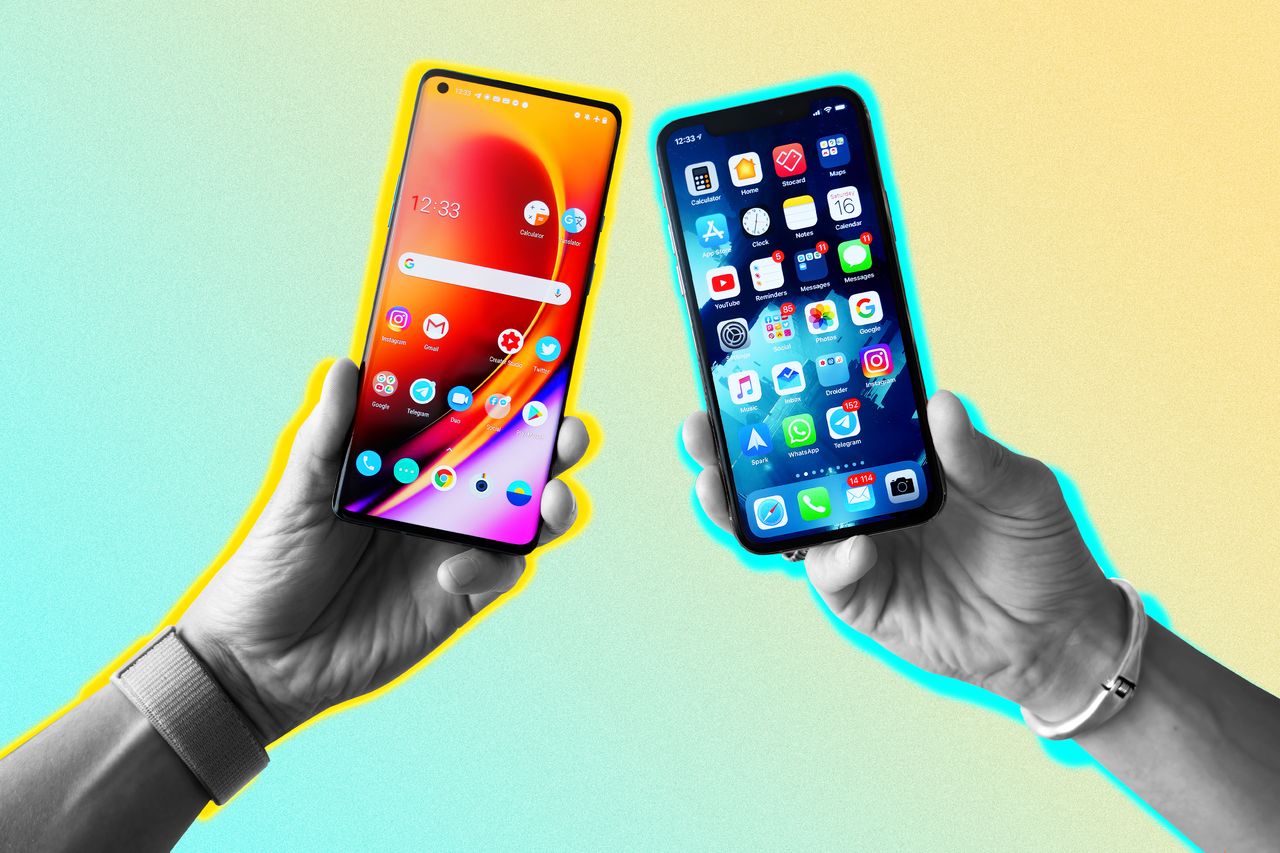You Love iPhone. Your Partner Loves Android. How to Make It Work.
The pros and cons of Apple and Google’s mobile operating systems—and how people can find neutral apps that work with both.
I’m on iOS. My husband, Will, is on Android. He says he’ll never switch.
When we met, Will had a Samsung Galaxy S3. He has stuck with Android phones since, except for a brief stint with the iPhone 6S Plus. When he ditched that phone, many of his texts got lost because they were still trying to get to him via iMessage. That quick taste of Apple’s lock-in only deepened his resolve. (Apple has since addressed the problem.)
There are several reasons for my iPhone preference. The main one is that I can’t seem to give up my iMessage group chats.
Generally, people aren’t prone to switching from Android to iOS or vice versa. But we’re in the throes of Smartphone Season, the time of year when Samsung, Apple and Google unveil their latest models, so maybe it’s worth the consideration. Also, there are ways to coexist harmoniously in an iOS-Android household, which I’ll discuss below.
The Never-iPhoners
I wanted to explore this iOS-Android divide, so I asked Will and other Android loyalists: What do you love about your platform?
I took Will’s Pixel 6a and started a voice recording. As we talked, the app transcribed our conversation in real time with near perfect precision. It’s one of the Android artificial intelligence features that I’m most jealous of. The second is Hold for Me, a tool that does just that when you’re waiting for a customer-service representative.
Will said he likes the swipe-style keyboard, which Android had long before iPhones did, and access to the file system, which allows him to sync data between his computer and phone over Wi-Fi. “Those are things that I’ve enjoyed for a long time,” Will, who works as an engineer at a medical software company, said. “It’s hard to break habits.”
Will isn’t bothered by those green-bubble text messages his Android phone triggers on iPhones. For one, he doesn’t see it—it all shows up the same on the Pixel. His family is mostly based in Europe, and they use Signal and other apps that look the same across platforms.
Google has tried to shame Apple into adopting the next-generation texting standard, called Rich Communication Services, to make all texts more like iMessage. For Apple, implementing it could take away a reason for people to stick with iPhones.
William Edmiston, a Samsung Galaxy S9 user, chose Android because of Google’s innovation and Apple’s tight control and closed system. “I too am a ‘never iPhone’ person,” said the Raleigh, N.C., resident, who works at an orthodontics technology company. “Android felt a bit more leading-edge, embraced by true tech enthusiasts.”
Mr. Edmiston also liked being able to treat the phone like a PC, and install different operating systems and apps. He admitted he’s now entrenched in Google’s own apps.
Both Android and Apple offer helpful guides for those who want to make the jump to the rival platform. But swapping systems is more than just transferring contacts and photos. It’s learning an entirely new language of gestures and menus, which can be frustrating.
“I frankly don’t think one operating system is better than the other, but I do think that changing operating systems is a massive pain in the butt,” my husband said.
iOS vs. Android
In the U.S., 55% of Americans use an iOS device. There are more Android users globally, where Google’s platform has 71% market share, according to analytics firm Statcounter.
Apple develops iOS exclusively for iPhones and iPads (with the iPadOS variation). Google develops Android but provides it freely as open-source software. That means Android can be used by any hardware maker. The most popular include Samsung, Xiaomi and OnePlus. Google makes its own Pixel-branded phones, and even Microsoft has dabbled in Android.
And while the two are constantly copying each other’s features, they differ in key ways:
• Hardware: iOS devices are only made by Apple, and you can choose from three or four new phones each year.
There are far more Android phones and designs to choose from, from the cheapest to the most extreme. On the low end, you can get a budget model for under $240. (At $719, the iPhone SE is Apple’s budget offering.) On the high end, Samsung sells Android phones with flexible screens that can flip and fold.
• Ecosystem: Apple designs both its hardware and software, a position the company touts as a benefit, as its devices “just work” together. AirPods that automatically connect to your Mac. A lost Apple Watch you can ping from your iPad.
Android devices aren’t integrated as seamlessly, though Google is doing more now. Last year, the company launched features so Android users could locate their phones or send texts from Chromebooks. A feature similar to Universal Clipboard—Apple’s cross-device copy-and-paste functionality—is coming to Android phones and tablets.
Samsung has its own gadget universe. Samsung Galaxy phones can beam videos to Samsung smart TVs, while Galaxy Watches can remotely control the camera shutter of Galaxy phones, for example.
• Updates: iPhones and iPads get a big feature-rich software update every fall, available to all eligible models. Apple supports phones for about five years.
Because the Android universe is fragmented, each phone maker has a different system-update timeline and policy. Typically, Google’s Pixel phones are first, as with Android 13, which launched earlier this month. Newer Pixel phones get five years of support, while older models get three. Samsung devices get three to four years of system updates, plus an additional year of security patches.
• Customisation: Historically, iPhones have been less customizable than Android devices. But the upcoming iOS 16 update allows users to style the lockscreen fonts and add little interactive widgets, something Android users have long been able to do.
Android is a better platform for techie tinkers. For example, you can set a third-party messaging app as the default. You can also sideload apps on Android—downloading them from outside of the Google Play store—though you do so at your own risk.
Google has increased efforts to keep bad apps out of its Play store. Still, the platform is more open, like a traditional PC, so users who aren’t careful can make their devices susceptible to malware and data leaks.
So Happy Together
Yes, iOS and Android feel different, and there will always be things one can do better than the other. But if you pick the right apps, they can dwell together happily.
Google is actually great at this: Will and I rely on Google Maps for location sharing, Google Photos for photo storage and Google Assistant to control smart-home products. These Google services all have iPhone apps, though the experience is more integrated on Android.
Any.do is a task list that works with Siri and Google Assistant, and has great widgets for both platforms. We also like the app Notion for things such as trip planning and household stuff.
For home entertainment, we’ve found Roku streaming devices, many of which support both Google Cast and Apple’s AirPlay, work well. So do Sonos speakers, which can be configured with Amazon Alexa or Google Assistant, and work with AirPlay.
Will and I won’t be on the same platforms anytime soon, but we make it work. At least until I need a great voice transcription and steal his phone. Again.
 Copyright 2020, Dow Jones & Company, Inc. All Rights Reserved Worldwide. LEARN MORE
Copyright 2020, Dow Jones & Company, Inc. All Rights Reserved Worldwide. LEARN MORE
This stylish family home combines a classic palette and finishes with a flexible floorplan
Just 55 minutes from Sydney, make this your creative getaway located in the majestic Hawkesbury region.
As Paris makes its final preparations for the Olympic games, its residents are busy with their own—packing their suitcases, confirming their reservations, and getting out of town.
Worried about the hordes of crowds and overall chaos the Olympics could bring, Parisians are fleeing the city in droves and inundating resort cities around the country. Hotels and holiday rentals in some of France’s most popular vacation destinations—from the French Riviera in the south to the beaches of Normandy in the north—say they are expecting massive crowds this year in advance of the Olympics. The games will run from July 26-Aug. 1.
“It’s already a major holiday season for us, and beyond that, we have the Olympics,” says Stéphane Personeni, general manager of the Lily of the Valley hotel in Saint Tropez. “People began booking early this year.”
Personeni’s hotel typically has no issues filling its rooms each summer—by May of each year, the luxury hotel typically finds itself completely booked out for the months of July and August. But this year, the 53-room hotel began filling up for summer reservations in February.
“We told our regular guests that everything—hotels, apartments, villas—are going to be hard to find this summer,” Personeni says. His neighbours around Saint Tropez say they’re similarly booked up.
As of March, the online marketplace Gens de Confiance (“Trusted People”), saw a 50% increase in reservations from Parisians seeking vacation rentals outside the capital during the Olympics.
Already, August is a popular vacation time for the French. With a minimum of five weeks of vacation mandated by law, many decide to take the entire month off, renting out villas in beachside destinations for longer periods.
But beyond the typical August travel, the Olympics are having a real impact, says Bertille Marchal, a spokesperson for Gens de Confiance.
“We’ve seen nearly three times more reservations for the dates of the Olympics than the following two weeks,” Marchal says. “The increase is definitely linked to the Olympic Games.”

Getty Images
According to the site, the most sought-out vacation destinations are Morbihan and Loire-Atlantique, a seaside region in the northwest; le Var, a coastal area within the southeast of France along the Côte d’Azur; and the island of Corsica in the Mediterranean.
Meanwhile, the Olympics haven’t necessarily been a boon to foreign tourism in the country. Many tourists who might have otherwise come to France are avoiding it this year in favour of other European capitals. In Paris, demand for stays at high-end hotels has collapsed, with bookings down 50% in July compared to last year, according to UMIH Prestige, which represents hotels charging at least €800 ($865) a night for rooms.
Earlier this year, high-end restaurants and concierges said the Olympics might even be an opportunity to score a hard-get-seat at the city’s fine dining.
In the Occitanie region in southwest France, the overall number of reservations this summer hasn’t changed much from last year, says Vincent Gare, president of the regional tourism committee there.
“But looking further at the numbers, we do see an increase in the clientele coming from the Paris region,” Gare told Le Figaro, noting that the increase in reservations has fallen directly on the dates of the Olympic games.
Michel Barré, a retiree living in Paris’s Le Marais neighbourhood, is one of those opting for the beach rather than the opening ceremony. In January, he booked a stay in Normandy for two weeks.
“Even though it’s a major European capital, Paris is still a small city—it’s a massive effort to host all of these events,” Barré says. “The Olympics are going to be a mess.”
More than anything, he just wants some calm after an event-filled summer in Paris, which just before the Olympics experienced the drama of a snap election called by Macron.
“It’s been a hectic summer here,” he says.

AFP via Getty Images
Parisians—Barré included—feel that the city, by over-catering to its tourists, is driving out many residents.
Parts of the Seine—usually one of the most popular summertime hangout spots —have been closed off for weeks as the city installs bleachers and Olympics signage. In certain neighbourhoods, residents will need to scan a QR code with police to access their own apartments. And from the Olympics to Sept. 8, Paris is nearly doubling the price of transit tickets from €2.15 to €4 per ride.
The city’s clear willingness to capitalise on its tourists has motivated some residents to do the same. In March, the number of active Airbnb listings in Paris reached an all-time high as hosts rushed to list their apartments. Listings grew 40% from the same time last year, according to the company.
With their regular clients taking off, Parisian restaurants and merchants are complaining that business is down.
“Are there any Parisians left in Paris?” Alaine Fontaine, president of the restaurant industry association, told the radio station Franceinfo on Sunday. “For the last three weeks, there haven’t been any here.”
Still, for all the talk of those leaving, there are plenty who have decided to stick around.
Jay Swanson, an American expat and YouTuber, can’t imagine leaving during the Olympics—he secured his tickets to see ping pong and volleyball last year. He’s also less concerned about the crowds and road closures than others, having just put together a series of videos explaining how to navigate Paris during the games.
“It’s been 100 years since the Games came to Paris; when else will we get a chance to host the world like this?” Swanson says. “So many Parisians are leaving and tourism is down, so not only will it be quiet but the only people left will be here for a party.”
This stylish family home combines a classic palette and finishes with a flexible floorplan
Just 55 minutes from Sydney, make this your creative getaway located in the majestic Hawkesbury region.






















